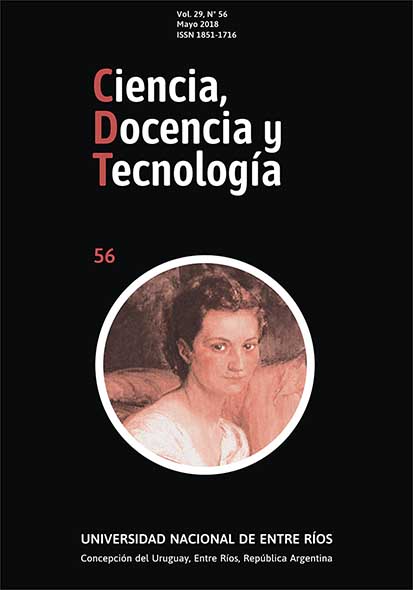Tannin addition in ruminant diets and their effect on quality and yield of meat
DOI:
https://doi.org/10.33255/2956/355Keywords:
phenolic compounds, meat quality, animal responseAbstract
The aim of the present work was to review the literature concerning the use of tannins in diets of ruminants and their incidence on parameters of meat quality and yield. Tannins are a group of phenolic compounds that play a fundamental role, although controversial, in animal digestion and performance. In addition they could affect product quality. The articles reveal the existence of numerous studies that evaluate the effects of the incorporation of tannins in the diet of small ruminants, oriented mainly to sheep productive response. Although there is information about its effect on cattle performance, there are not enough records related to its influence on physical and chemical parameters related with meat quality traits.Downloads
References
AERTS R.J.; BARRY T.N.; McNABB W.C. (1999). Polyphenols and agriculture: beneficial effects of proanthocyanidins in forages, en: Agriculture, Ecosystems and Environment, 75:1-12.
BARRAGÁN GONZÁLEZ, H.; HERNÁNDEZ MENDO, O.; HERNÁNDEZ SÁNCHEZ, D.; SATURNINO MORA, J.; ARANDA OSORIO, G.; PONCE ALQUICIRA, E. (2014). Estabilidad oxidativa de la carne de bovino en respuesta a suplementación con taninos en la dieta. (pp.241-244). XLI Reunión de la Asociación Mexicana para la Producción Animal y Seguridad Alimentaria A.C. (AMPA) y VII Reunión Nacional de Sistemas Agro y Silvopastoriles. México.
BARRY, T. N.; ALLSOP, T. F.; REDEKOPP, C. (1986). The role of condensed tannins in the nutritional value of Lotus pedunculatus for sheep: *5. Effects on the endocrine system and on adipose tissue metabolism, en: British Journal of Nutrition, 56(3):607-614.
BROGNA, D.M.R.; TANSAWAT, R.; CORNFORTH, D.; WARD, R.; BELLA, M.; LUCIANO, G. et al. (2014). The quality of meat from sheep treated with tannin- and saponin-based remedies as a natural strategy for parasite control, en: Meat Science, 96:744-749.
BUCCIONI, A.; MINIERI, S.; RAPACCINI, S.; ANTONGIOVANNI, M.; MELE, M. (2011). Effect of chestnut and quebracho tannins on fatty acid profile in rumen liquid- and solid-associated bacteria: an in vitro study, en: Animal, 5(10):1521-1530.
FAUSTMAN, C.; SUN, Q.; MANCINI, R.; SUMAN, S. P. (2010). Myoglobin and lipid oxidation interactions: Mechanistic bases and control, en: Meat Science, 86(1): 86-94.
FRUTOS, P.; HERVÁS, G.; GIRÁLDEZ, F. J.; MANTECÓN, A. R. (2004a). An in vitro study on the ability of polyethylene glycol to inhibit the effect of quebracho tannins and tannic acid on rumen fermentation in sheep, goats, cows, and deer, en: Australian Journal of Agricultural Research, 55:1125-1132.
FRUTOS, P.; HERVÁS, G.; GIRÁLDEZ, F. J.; MANTECÓN, A. R. (2004b). Review: Tannins and ruminant nutrition, en: Spanish Journal of Agricultural Research, 2(2):191-202.
JERONIMO, E.; ALVES, A.P.; DENTINHO, M.T.P.; MARTINS, S.V.; PRATES, J.A.M.; VASTA, V. et al. (2010). The effect of grape seed extract, Cistus ladanifer L. and vegetable oil supplementation on fatty acid composition of abomasal digesta and intramuscular fat of lambs, en: Journal of Agricultural and Food Chemistry, 58:10710-10721.
JONES, E. T.; MANGAN, J. L. (1977). Complexes of the condensed tannins of sainfoin (Onobrychis viciifolia Scop.) with fraction 1 leaf protein and with submixillary mucoprotein, and their reversal by polyethylene glycol and pH, en: Journal of the Science of Food and Agriculture, 28:126-136.
KRONBERG, S. L.; SCHOLLJEGERDES, E. J.; BARCELÓ-COBLIJN, G.; MURPHY, E. J. (2007). Flaxseed Treatments to Reduce Biohydrogenation of α-Linolenic Acid by Rumen Microbes in Cattle, en: Lipids, 42:1105-1111.
KRUEGER, W.K.; GUTIERREZ-BAÑUELOS, H.; CARSTENS, G.E.; MIN, B.R.; PINCHAK, W.E.; GOMEZ, R.R. et al. (2010). Effects of dietary tannin source on performance, feed efficiency, ruminal fermentation, and carcass and non-carcass traits in steers fed a high-grain diet, en: Animal Feed Science and Technology, 159:1-9.
LARRAÍN, R.E.; SCHAEFER, D.M.; RICHARDS, M.P.; REED, J.D. (2008). Finishing steers with diets based on corn, high-tannin sorghum or a mix of both: Color and lipid oxidation in beef, en: Meat Science, 79:656-665.
LARRAÍN, R.E.; SCHAEFER, D.M.; ARP, S.C.; CLAUS, J.R.; REED, J.D. (2009). Finishing steers with diets based on corn, high-tannin sorghum, or a mix of both: feedlot performance, carcass characteristics, and beef sensory attributes, en: Journal of Animal Science, 87(6):2089-95.
LIU, H.; LI, K.; MINGBINC, L; ZHAO, J.; XIONG, B. (2016). Effects of chestnut tannins on the meat quality, welfare, and antioxidant status of heat-stressed lambs, en: Meat Science, 116:236-242.
LUCIANO, G.; MONAHAN, F.J.; VASTA, V.; BIONDI, L.; LANZA, M.; PRIOLO, A. (2009). Dietary tannins improve lamb meat colour stability, en: Meat Science, 81:120-125.
MAPIYE, C.; CHIMONYO, M.; DZAMA, K.; MUCHENJE, V.; STRYDOM, P.E. (2010). Meat quality of Nguni steers supplemented with Acacia karroo leaf-meal, en: Meat Science, 84:621-627.
MAQSOOD, S.; BENJAKUL, S. (2010). Preventive effect of tannic acid in combination with modified atmospheric packaging on the quality losses of the refrigerated ground beef, en: Food Control, 21:1282-1290.
MIN, B.R.; BARRY, T.N.; ATTWOOD, G.T.; McNABB, W.C. (2003). The effect of condensed tannins on the nutrition and health of ruminants fed fresh temperate forages: a review, en: Animal Feed Science and Technology, 106:3-19.
MIN, B.R.; HERNANDEZ, K.; PINCHAK, W.E.; ANDERSON, R.C.; MILLER, J.E.; VALENCIA, E. (2015). Effects of Plant Tannin Extracts Supplementation on Animal Performance and Gastrointestinal Parasites Infestation in Steers Grazing Winter Wheat, en: Open Journal of Animal Sciences, 5:343-350.
MORALES, R.; UNGERFELD, E.M (2015). Use of tannins to improve fatty acids profile of meat and milk quality in ruminants: A review, en: Chilean Journal of Agricultural Research, 75(2):239-248.
MUELLER-HARVEY, I. (2006). Unravelling the conundrum of tannins in animal nutrition and health, en: Journal of the Science of Food and Agriculture, 86(13):2010–2037.
MUIR, L. A.; WIEN, S.; DUQUETTE, P. F.; RICKES, E. L.; CORDES, E. H. (1983). Effect of exogenous growth hormone and diethylstilbestrol on growth and carcass composition of growing lambs, en: Journal of Animal Science, 56:1315-1323.
PASINATO, A. (2010). Utilización de taninos condensados en rumiantes. (pp.25-32). En Pasinato, A.; Santini, F.; Geraci, J. (Eds.). Jornadas proyecto nacional de nutrición animal. Concepción del Uruguay: INTA-EEA Concepción del Uruguay.
PORDOMINGO, A. J.; VOLPI LAGRECA, G.; STEFANAZZI, I. N.; PORDOMINGO, A. B. (2006). Efecto de la inclusión de taninos versus monensina y de soja cruda en dietas basadas en grano entero, sin fibra larga, en engorde de vaquillonas a corral, en: Boletín de Divulgación Técnica, 90:67-73.
PORDOMINGO, A.J.; VOLPI LAGRECA, G.; GARCÍA, P.T.; GRIGIONI, G. (2013). Agregado de taninos de quebracho en dietas con 50 o 70% de grano de maíz sobre la producción individual, características de la res y la carne de vaquillonas de engorde a corral. (pp.125-139). En: Pordomingo, A.J. (Ed.). Avances en calidad de carne bovina-Implicancias de la alimentación, genética y el manejo.
PRIOLO, A.; WAGHORN, G.C.; LANZA, M.; BIONDI, L.; PENNISI, P. (2000). Polyethylene glycol as a means for reducing the impact of condensed tannins in carob pulp: effects on lamb growth performance and meat quality, en: Journal of Animal Science, 78:810-816.
PRIOLO, A., BELLA, M., LANZA, M., GALOFARO, V., BIONDI, L., BARBAGALLO, D. et al. (2005). Carcass and meat quality of lambs fed fresh sulla (Hedysarum coronarium L.) with or without polyethylene glycol or concentrate, en: Small Ruminant Research, 59:281-288.
PRIOLO, A.; VASTA, V. (2007). Effects of tannin-containing diets on small ruminant meat quality, en: Italian Journal of Animal Science, 6(1):527-530.
PRIOLO, A.; VASTA, V.; FASONE, V.; LANZA, C.M.; SCERRA, M.; BIONDI, L. et al. (2009). Meat odour and flavour and indoles concentration in ruminal fluid and adipose tissue of lambs fed green herbage or concentrates with or without tannins, en: Animal, 3:454-460.
SCHREURS, N.M.; LANE, G.A.; TAVENDALE, M.H.; BARRY, T.N.; MCNABBA, W.C. (2008). Pastoral flavour in meat products from ruminants fed fresh forages and its amelioration by forage condensed tannins, en: Animal Feed Science and Technology, 146(3):193-221.
SCHWAB, C.G. (1995). Protected proteins and amino acids for ruminants. (pp.115-141). En: Wallace, R.J.; Chesson, A. (Eds.). Biotechnology in animal feeds and animal feeding. Weinhein (Germany): V.C.H. Press.
SELJE, N.; HOFFMANN, E. M.; MUETZEL, S.; NINGRAT, R.; WALLACE, R. J.; BECKER, K. (2007). Results of a screening programme to identify plants or plant extracts that inhibit ruminal protein degradation, en: British Journal of Nutrition, 98:45-53.
SHAH, M.A; DON BOSCO, S.J.; MIR, S.A. (2014). Plant extracts as natural antioxidants in meat and meat products, en: Meat Science, 98:21-33.
VAHMANI, P.; MAPIYE, C.; PRIETO, N.; ROLLAND, D.C.; MCALLISTER, T.A.; AALHUS, J.L. et al.(2015). The scope for manipulating the polyunsaturated fatty acid content of beef: A review, en: Journal of Animal Science and Biotechnology, 6:29.
VASTA, V.; PENNISI, P.; LANZA, M.; BARBAGALLO, D.; BELLA, M.; PRIOLO, A. (2007). Intramuscular fatty acid composition of lambs given a tanniniferous diet with or without polyethylene glycol supplementation, en: Meat Science, 76:739-745.
VASTA, V.; NUDDA, A.; CANNAS, A.; LANZA, M.; PRIOLO, A. (2008). Alternative feed resources and small ruminants meat and milk quality, en: Animal Feed Science and Technology, 147:223-246.
VASTA, V.; MAKKAR, H.P.S.; MELE, M.; PRIOLO, A. (2009a). Ruminal biohydrogenation as affected by tannins in vitro, en: British Journal of Nutrition, 102:82-92.
VASTA, V.; MELE, M.; SERRA, A.; SCERRA, M.; LUCIANO, G.; LANZA, M. et al. (2009b). Metabolic fate of fatty acids involved in ruminal biohydrogenation in sheep fed concentrate or herbage with or without tannins, en: Journal of Animal Science, 87:2674-2684.
VASTA, V.; PRIOLO, A.; SCERRA, M.; HALLETT, K.G.; WOOD, J.D.; DORAN, O. (2009c). Δ9 desaturase protein expression and fatty acid composition of longissimus dorsi muscle in lambs fed green herbage or concentrate with or without added tannins, en: Meat Science, 82:357-364.
VASTA, V.; LUCIANO, G. (2011). The effects of dietary consumption of plants secondary compounds on small ruminants’ products quality, en: Small Ruminant Research, 101:150-159.
VOLPI-LAGRECA, G.; PORDOMINGO, A. J.; ALENDE, M.; PORDOMINGO, A. B.; GRIGIONI, G.; CARDUZA, F. et al. (2013). Efecto de la inclusión de taninos, monensina y soja cruda en dietas basadas en grano de maíz entero sobre la composición lipídica y las características físicas de la carne. (pp.91-96). En: Pordomingo, A.J. (Ed.). Avances en calidad de carne bovina, Implicancias de la alimentación, genética y el manejo.
VOLPI-LAGRECA, G.; ALENDE, M.; PORDOMINGO, A.J.; BABINEC, F.; CERON, M. (2015). Engorde de bovinos a corral: Efectos de monensina y de dos niveles de taninos condensados de quebracho sobre el comportamiento productivo, la fermentación ruminal y la degradabilidad in situ de la materia seca y de la proteína, en: Revista Argentina de Producción Animal, 33(2):65-77.
WAGHORN, G.C.; SHELTON, I.D.; MCNABB, W.C.; MCCUTCHEON, S.N. (1994). Effects of condensed tannins in Lotus pedunculatus on its nutritive value for sheep. 2. Nitrogenous aspects, en: Journal of Agricultural Science, 123:109-119.
WAGHORN, G. (2008). Beneficial and detrimental effects of dietary condensed tannins for sustainable sheep and goat production-Progress and challenges, en: Animal Feed Science and Technology, 147:116-139.
YOUNG, O.A.; LANE, G.A.; PRIOLO, A.; FRASER, K. (2003). Pastoral and species flavour in lambs raised on pasture, lucerne or maize, en: Journal of the Science of Food and Agriculture, 83:93-104.
Downloads
Published
How to Cite
Issue
Section
License
Copyright (c) 2018 Carolina Jenko, Patricia Bonato, Romina Fabre, Flavia Perlo, Osvaldo Tisocco, Gustavo Teira

This work is licensed under a Creative Commons Attribution-NonCommercial-ShareAlike 4.0 International License.
The authors retain the copyright and grant the journal the right to be the first publication of the work, as well as licensing it under a Creative Commons Attribution License that allows others to share the work with an acknowledgment of the authorship of the work and publication initial in this magazine. All content is published under the Creative Commons 4.0 international license: Attribution-Non-Commercial-Share Alike.






